Los Cinco Terremotos más fuertes en la historia/The five strongest Earthquakes in history
En este trabajo les presento un resumen de los 5 terremotos más fuertes de la historia d ela humanidad, dondo ocurrieron y sus consecuencias.
In this paper I present a summary of the 5 strongest earthquakes in the history of humanity, where they occurred and their consequences.
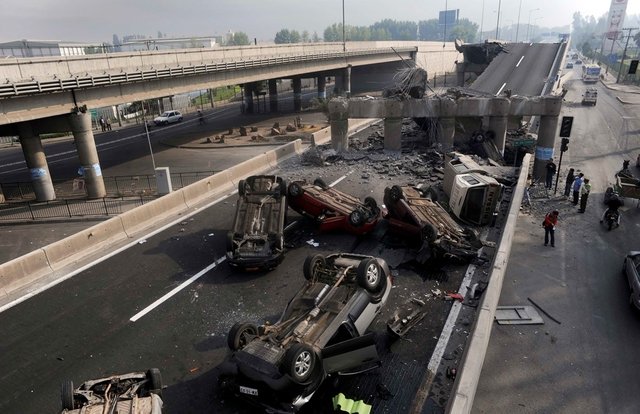
Terremoto de 8.8 en Santiago de Chile el 27 de Febrero de 2010. Fuente de la Imágen
Como dato curioso, nuestro planeta y su corteza terreste, que esta formada por las llamadas placas tectónicas, se encuentran en constantemente movimiento que son imperceptibles. No obstante, cuando estos son obstaculizados se acumula la energía hasta llegar a tal magnitud que se manifiestan en movimientos bruscos que los conocemos como terremoto.
Por otra parte, es importante destacar la forma de clasificar los terremotos, para lo que se toma en cuenta la magnitud y la intensidad de los mismo.
Todos hemos escuchado cuando ocurre un sismo que tiene una magnitud de X en la Escala de Richter, esto se debe en honor al creador de dicha escala, este sismólogo estadounidense en 1935 diseño una escala logarítmica de magnitudes cuyo rango es del 1 al 10, capaz de medir la cantidad de energía liberada de un movimiento telúrido desde su centro.
As a curious fact, our planet and its terrestrial crust, which is formed by the so-called tectonic plates, are in constant movement that are imperceptible. However, when these are hindered the energy accumulates until reaching such a magnitude that they manifest themselves in sudden movements that we know as an earthquake.
On the other hand, it is important to highlight the way to classify earthquakes, for which the magnitude and intensity of them is taken into account.
We have all heard when an earthquake occurs that has a magnitude of X on the Richter Scale, this is due to the creator of that scale, this American seismologist in 1935 designed a logarithmic scale of magnitudes whose range is from 1 to 10, capable to measure the amount of energy released from a telluric movement from its center.
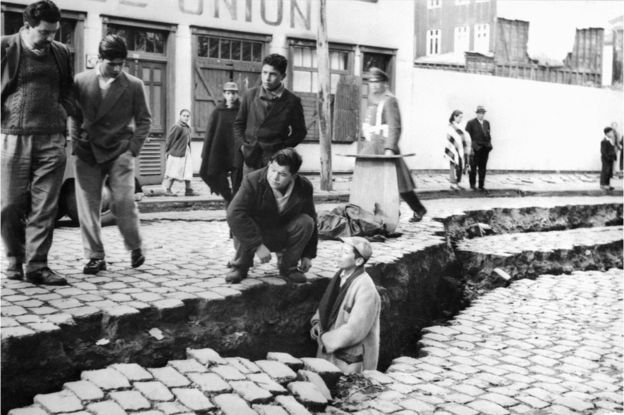
Valdivia Chile 22 de Mayo de 1960 Fuente de la imagen

1.-Valdivia, Chile: Magnitud 9.5 (1960)
2.-Alaska, Estados Unidos: Magnitud 9.2 (1964)
3.-Isla de Sumatra: Magnitud 9.1 (2004)
4.-Tohoku, Japón: Magnitud 9.1 (2011)
5.-Kamchatka, Rusia: Magnitud 9.0 (1952):Kamchatka (Rusia)
6.-Región del Maule, Chile: Magnitud 8.8 (2010)
7.-Ecuador-Colombia: Magnitud 8.8 (1906)
8.-Isla Rat, Alaska: Magnitud 8.7 (1965)
9.-Tibet: Magnitud 8.6 (1950)
10.-Sumatra: Magnitud 8.6 (2012)
11.-Indonesia: Magnitud 8.6 (2005)
12.- Islas Aleutian, Alaska: Magnitud 8.6 (1957)
13.- Sur de Alaska: Magnitud 8.6 (1946)
14.- Mar de banda: Magnitud 8.5 (1938)
15.- Atacama, Chile: Magnitud 8.5 (1922)
16.- Islas Kuril: Magnitud 8.5 (1963)
17.- Kamchatka, Rusia: Magnitud 8.4 (1923)
18.- Sumatra, Indonesia: Magnitud 8.4 (2007)
19.- Arequipa, Perú: Magnitud 8.4 (2001)
20.- Honshu, Japón: Magnitud 8.4 (1933)
1.-Valdivia, Chile: Magnitude 9.5 (1960)
2.-Alaska, United States: Magnitude 9.2 (1964)
3.-Island of Sumatra: Magnitude 9.1 (2004)
4.-Tohoku, Japan: Magnitude 9.1 (2011)
5.-Kamchatka, Russia: Magnitude 9.0 (1952): Kamchatka (Russia)
6.-Region of Maule, Chile: Magnitude 8.8 (2010)
7.-Ecuador-Colombia: Magnitude 8.8 (1906)
8.-Rat Island, Alaska: Magnitude 8.7 (1965)
9.-Tibet: Magnitude 8.6 (1950)
10.-Sumatra: Magnitude 8.6 (2012)
11.-Indonesia: Magnitude 8.6 (2005)
12.- Aleutian Islands, Alaska: Magnitude 8.6 (1957)
13.- South of Alaska: Magnitude 8.6 (1946)
14.- Sea of band: Magnitude 8.5 (1938)
15.- Atacama, Chile: Magnitude 8.5 (1922)
16.- Kuril Islands: Magnitude 8.5 (1963)
17.- Kamchatka, Russia: Magnitude 8.4 (1923)
18.- Sumatra, Indonesia: Magnitude 8.4 (2007)
19.- Arequipa, Peru: Magnitude 8.4 (2001)
20.- Honshu, Japan: Magnitude 8.4 (1933)

Los cinco Terremotos más fuertes de la historia
Número 1: Valdivia, Chile (1960)
Este terremoto hasta la fecha ha sido el de mayor magnitud en la historia de la humanidad cuya magnitud fue de 9.5 en la Escala de Richter con una duración entre 8 y 11 minutos, este evento ocurrió el 22 de Mayo de 1960, el cual hizo que Valdivia se hundiera 4 m bajo el nivel del mar y dejo 2.000.000 de damnificados, miles de muertos y heridos; además provocó la erupción del volcán Puyehue, este movimiento telúrico fue tan intenso que lo sintieron en gran parte del cono sur, provocando un tsunami que se extendió por el Océano Pacífico y llegó hasta Hawái y Japón.
The five strongest Earthquakes in history
Number 1: Valdivia, Chile (1960)
This earthquake to date has been the greatest magnitude in the history of humanity whose magnitude was 9.5 on the Richter scale with a duration between 8 and 11 minutes, this event occurred on May 22, 1960, which caused Valdivia to sink 4 meters below sea level and left 2,000,000 victims, thousands of dead and injured; also caused the eruption of the Puyehue volcano, this telluric movement was so intense that they felt it in much of the southern cone, causing a tsunami that spread across the Pacific Ocean and reached Hawaii and Japan.
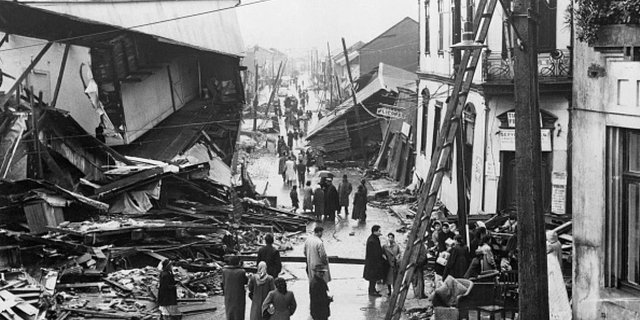
Valdivia 1960. Fuente de la Imágen

Number 2: Alaska, Estados Unidos (1964)
Este evento sismico ha sido considerado el más poderoso en la historia de Norteamerica y el segundo en la historia de la humanidad, cuya duración fue de 4 minutos y una magnitud en la Escala de Richter de 9.2, ocurrido en Alaska el 27 de marzo de 1964, provocando el segundo tsunami más agresivo de la historia de la humanidad, según wikipedia:
la altura de ola máxima registrada fue de 67 metros en la ensenada de Valdez con olas de más de 5 metros de alto.
Los daños ocasionados por este terremoto y posterior tsunami dejaron un saldo de 139 personas fallecidas, de las cuales fueron 124 por el tsunami y 15 por el terremoto.
Este terromoto fue tan fuerte que trajo como consecuencia que más de 200.000 km cuadrados de la corteza de la superficie terrestre sufrieron daños, asi como cambios temporales del suelo en algunas áreas tales comom el colapso que sufrieron los acantilados de arcillas de los cerros Turnagain, donde fueron afectadas un gran número de viviendas.
Number 2: Alaska, United States (1964)
This seismic event has been considered the most powerful in the history of North America and the second in the history of humanity, whose duration was 4 minutes and a magnitude on the Richter Scale of 9.2, occurred in Alaska on March 27, 1964 , causing the second most aggressive tsunami in the history of mankind, according to wikipedia:
the maximum recorded wave height was 67 meters in the Valdez inlet with waves over 5 meters high.
The damage caused by this earthquake and subsequent tsunami left a balance of 139 people dead, of which 124 were due to the tsunami and 15 to the earthquake.
This earthquake was so strong that it resulted in more than 200,000 square km of the crust of the Earth's surface being damaged, as well as temporary changes in the soil in some areas, such as the collapse suffered by the clayey cliffs of the Turnagain hills, where A large number of houses were affected.
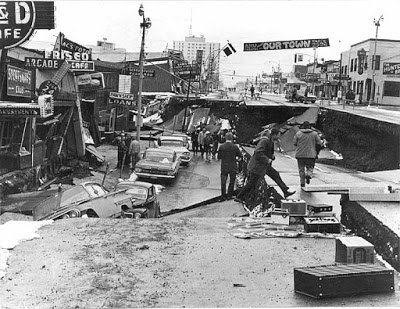
Alaska 1964-Anchorage después del terremoto. Fuente

Number 3: Isla de Sumatra Indonesia (2004)
Este fue un terremoto submarino con epicentro en la costa de Banda Aceh (Indonesia), ocurrió el 26 de diciembre de 2004, con magnitud de 9.1 en la Escala de Richter generando un devastador tsunami que afectó a todas las islas de la zona, con un saldo aproximado de 230 mil personas muertas en Sri Lanka, islas Maldivas, India, Tailandia, Malasia, Bangladesh y Myammar (antigua Birmania).
Este terrible evento tuvo una duración entre 8,3 a 10 min y cuya intensidad fue tan fuerte que fue capaz de que el planeta vibrara un centimetro asi como que se produjeran terremotos en Alaska estando este lugar tan lejano del epicentro.
Number 3: Island of Sumatra Indonesia (2004)
This was an underwater earthquake with epicenter on the coast of Banda Aceh (Indonesia), occurred on December 26, 2004, with a magnitude of 9.1 on the Richter Scale generating a devastating tsunami that affected all the islands in the area, with a approximately 230 thousand people killed in Sri Lanka, Maldives, India, Thailand, Malaysia, Bangladesh and Myammar (formerly Burma).
This terrible event lasted between 8.3 to 10 min and its intensity was so strong that it was able to make the planet vibrate a centimeter as well as earthquakes in Alaska being this place so far from the epicenter.
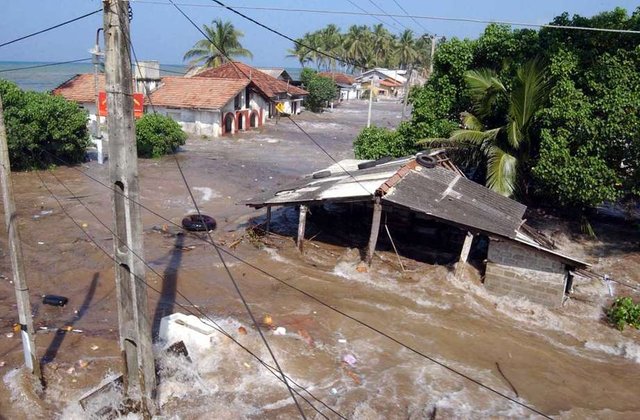

Number 4: Tohoku, Japón (2011)
El 11 de Marzo de 2011 ocurrió un terremoto y posterior tsunami en Japón con una magnitud 9.0 grados en la Escala de Richter, con olas que llegaron a 40.5 metros, ocasionando más de 15 mil muertes y casi 4000 mil personas desaparecidas, cuyo epicentro se localizó en el mar cerca de la costa de Honshu a aproximadamente 130 km al este de Sendai y tuvo una duración de dos minutos.
Number 4: Tohoku, Japan (2011)
On March 11, 2011 an earthquake and subsequent tsunami occurred in Japan with a magnitude of 9.0 degrees on the Richter Scale, with waves that reached 40.5 meters, causing more than 15 thousand deaths and almost 4000 thousand people missing, whose epicenter was located in the sea near the coast of Honshu approximately 130 km east of Sendai and lasted two minutes.
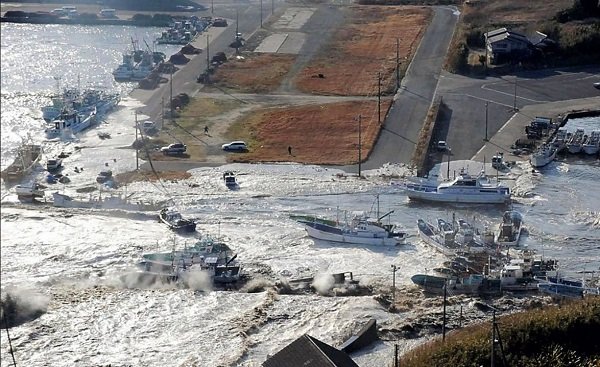
Tsunami de Japon 2011. Fuente

Number 5: Kamchatka, Rusia (1952)
Este terremoto esta en el quinto lugar de los considerados como más fuertes ocurridos en la historia de la humanidad, ocurrió el 4 de noviembre de 1952, con una magnitud de 9.0 grados en la Escala de Richter .
Este sismo provocó tsunamis que afectaron a Hawai, Japón, Alaska, Chile, Nueva Zeland, las Islas Midway, Cocos, Hawái, Alaska y California, con olas que alcanzaron 3,2 metros de alto.
Tuvo una duración aproximada de 5 y 10 minutos y ocasionó perdidas humanas de alrededor de 2366 fallecidos en la península de Kamchatka.
Number 5: Kamchatka, Russia (1952)
This earthquake is in the fifth place of those considered as strongest occurred in the history of mankind, occurred on November 4, 1952, with a magnitude of 9.0 in the Richter Scale.
This earthquake caused tsunamis that affected Hawaii, Japan, Alaska, Chile, New Zealand, the Midway Islands, Cocos, Hawaii, Alaska and California, with waves that reached 3.2 meters high.
It lasted approximately 5 and 10 minutes and caused human losses of about 2366 deaths in the Kamchatka Peninsula.
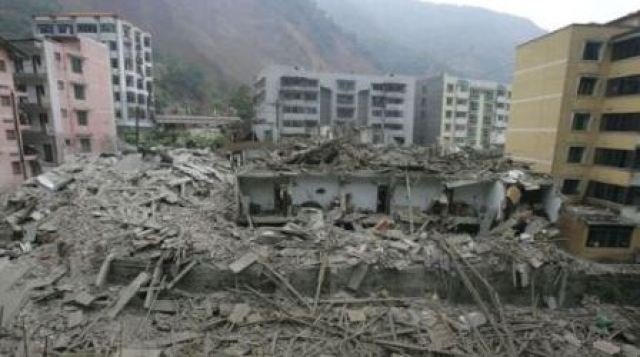

Espero que les haya gustado el tema analizado en esta publicación, el cual fue seleccionado por mi y es de mi autoría basado en datos tomadas de las diversas fuentes referenciadas a continuación.
I hope you liked the topic analyzed in this publication, which was selected and is my responsibility based on data taken from the various sources referenced below.

https://www.muyhistoria.es/contemporanea/articulo/los-cinco-terremotos-mas-intensos-de-la-historia
https://www.bbc.com/mundo/noticias-america-latina-41343606
https://www.excelsior.com.mx/2012/06/12/global/840805
https://www.eluniversal.com.mx/mundo/cuales-han-sido-los-terremotos-mas-poderosos-de-la-historia
https://www.ahoranoticias.cl/noticias/mundo/205385-estos-son-los-20-terremotos-de-mayor-magnitud-en-la-historia.html
https://www.publimetro.cl/cl/noticias/2018/05/22/valdivia-1960-cuando-mundo-parecio-acabarse-37-terremotos-juntos-mas-8-minutos-temblando-intensidad-historica-95-una-explosion-volcanica-tsunami.html


Excelente trabajo @janettyanez, saludos
Nice post..
Thank you so much for sharing this amazing post with us!
Have you heard about Partiko? It’s a really convenient mobile app for Steem! With Partiko, you can easily see what’s going on in the Steem community, make posts and comments (no beneficiary cut forever!), and always stayed connected with your followers via push notification!
Partiko also rewards you with Partiko Points (3000 Partiko Point bonus when you first use it!), and Partiko Points can be converted into Steem tokens. You can earn Partiko Points easily by making posts and comments using Partiko.
We also noticed that your Steem Power is low. We will be very happy to delegate 15 Steem Power to you once you have made a post using Partiko! With more Steem Power, you can make more posts and comments, and earn more rewards!
If that all sounds interesting, you can:
Thank you so much for reading this message!
Hola soy @wilkeny excelente publicación. No olvides visitar nuestro reporte semanal.
Arriba arriba @steemitvenezuela.
"Steemitvenezuela es una comunidad en crecimiento que apoya, educa y motiva a los autores con contenido en Español. Juntos somos más y con Steemit podemos lograrlo"
@wilkeny - Equipo de curación de @SteemitVenezuela
Síguenos y apóyanos en los siguientes enlaces:
Chat de Discord | Grupo FB
Repollo es un proyecto que tiene como misión entregar recompensas a todos los creadores de contenido. Tú puedes recibir un voto de Repollo siempre si decides adquirir una membresía delegando desde 50 SP. @Cervantes apoya a Repollo, Puedes votar por ellos como Witness aquí. No te olvides de seguir promocionando tus publicaciones en nuestro Discord.